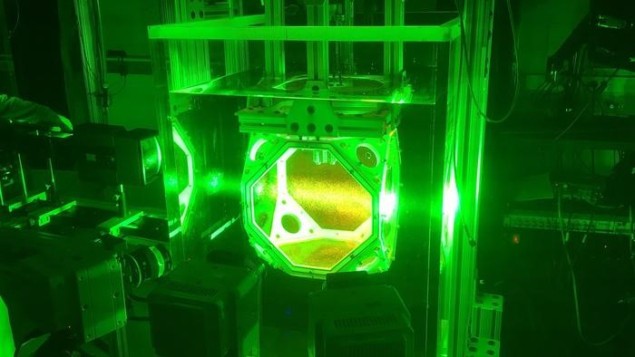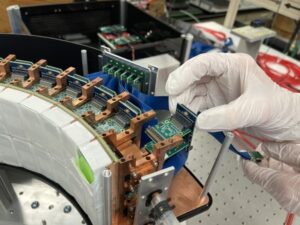
Researchers in the US have isolated a ball of turbulence inside a tank of water and sustained it by firing vortex rings from the corners of the tank. William Irvine and colleagues at the University of Chicago say that their new technique could lead to a transformation in the way turbulence is studied experimentally.
From eddies in a stream to the swirling of gas in interstellar space, turbulence underpins the behaviour of many different systems in nature. Its main characteristics are easy to spot and include irregular and erratic fluctuations in velocity and pressure. Yet despite their ubiquity, researchers struggle to describe exactly how turbulent fluids behave.
“Turbulence appears everywhere around us, but it keeps eluding what physicists consider a satisfying description.” Irvine explains. “For example, if you ask, can I predict what happens next when I poke this region of turbulence? The answer is no. Not even really with a supercomputer.”
Controlled disturbances
While turbulence can be created and studied in the lab, it is very difficult to prevent a turbulent fluid from interacting with the walls of its container, or the stirring apparatus used to generate turbulence. So far, this setback has prevented physicists from understanding how turbulent fluids evolve over time if left undisturbed, or how they respond to controlled disturbances.
To address this challenge, Irvine’s team sought to create a completely isolated region of turbulence using vortex rings. These are circular swirls of fluid that generate turbulence as they collide with each other.
At first, Irvine and colleagues did this by placing vortex-generating ring jets at either end of a water tank. The water was seeded with bubbles to visualise the motions of the rings. Although turbulence was observed initially, the flows eventually recombined to create new sets of rings, which deflected away from the original point of collision.
Eight vortex rings
In their latest study, Irvine’s team instead placed a ring jet at each corner of the tank – with far more interesting results. As the eight vortex rings collided, they created a roughly spherical ball of turbulence at the centre of the tank. Not only was the ball completely isolated from the tank’s walls; it could be sustained simply by firing more vortex rings into the tank periodically.
“No one knew this was even possible,” says team member Takumi Matsuzawa. “Turbulence is very good at mixing things; if you mix your milk into your coffee, you can only get one or two swirls in before it becomes completely mixed. The fact we can contain it in place is very surprising.”
It’s like calmly sitting in a field with a picnic and watching a storm raging 50 feet away
William Irvine
With this setup, the team could combine vortex rings like LEGO blocks – controlling parameters including the rings’ energy and helicity – the latter describing whether the vortices rotated clockwise or anticlockwise.

Is turbulent flow universal after all?
In turn, they could fine-tune the parameters of the turbulence inside the ball, then observe how it evolved as they sustained it with more vortex rings – or how it dissipated as they stopped adding new rings. “It’s like calmly sitting in a field with a picnic and watching a storm raging 50 feet away,” Irvine describes.
The researchers now hope their work could lead to a breakthrough in the development of new techniques for studying turbulence. By sculpting turbulent flows using vortex rings, they suggest that turbulence could be treated as a state of matter with features that can be carefully controlled and manipulated.
In turn, this could pave the way for a diverse array of new experiments, exploring many different examples of turbulent flows in nature. “I really hope this can help open up a new playground in the field,” Irvine says.
The research is described in Nature Physics.
- SEO Powered Content & PR Distribution. Get Amplified Today.
- PlatoData.Network Vertical Generative Ai. Empower Yourself. Access Here.
- PlatoAiStream. Web3 Intelligence. Knowledge Amplified. Access Here.
- PlatoESG. Automotive / EVs, Carbon, CleanTech, Energy, Environment, Solar, Waste Management. Access Here.
- BlockOffsets. Modernizing Environmental Offset Ownership. Access Here.
- Source: https://physicsworld.com/a/balls-of-turbulence-are-isolated-using-vortex-rings/
- :has
- :is
- :not
- $UP
- 50
- a
- adding
- address
- After
- All
- Although
- and
- answer
- appears
- ARE
- around
- Array
- AS
- At
- away
- ball
- BE
- becomes
- before
- Blocks
- breakthrough
- but
- by
- cameras
- CAN
- carefully
- centre
- challenge
- characteristics
- chicago
- Coffee
- colleagues
- Collide
- combine
- completely
- Consider
- contain
- Container
- controlled
- controlling
- Corner
- corners
- could
- create
- created
- describe
- described
- description
- Despite
- Development
- DID
- different
- difficult
- diverse
- each
- easy
- either
- end
- energy
- Even
- eventually
- evolve
- evolved
- exactly
- example
- examples
- experiments
- Explains
- Exploring
- fact
- far
- Features
- Feet
- field
- firing
- First
- flow
- Flowing
- Flows
- fluctuations
- fluid
- For
- from
- GAS
- generate
- get
- good
- happens
- Have
- help
- hope
- How
- HTTPS
- i
- if
- image
- in
- include
- Including
- information
- initially
- inside
- instead
- interacting
- interesting
- interstellar
- into
- isolated
- issue
- IT
- ITS
- Jets
- jpg
- lab
- lasers
- latest
- lead
- left
- like
- Main
- manipulated
- many
- Matter
- max-width
- member
- Milk
- mix
- mixed
- Mixing
- more
- motions
- Nature
- New
- next
- no
- now
- observe
- of
- ONE
- only
- open
- or
- original
- Other
- out
- over
- parameters
- pave
- Physics
- Physics World
- pipe
- Place
- placing
- plato
- Plato Data Intelligence
- PlatoData
- Point
- Poke
- possible
- predict
- pressure
- prevent
- raging
- really
- region
- research
- researchers
- Respond
- Results
- Ring
- roughly
- say
- says
- Sets
- setup
- simply
- Sitting
- So
- so Far
- sought
- Space
- Spot
- State
- State of matter
- stopped
- Storm
- stream
- Struggle
- studied
- Study
- Studying
- suggest
- supercomputer
- surprising
- Systems
- tank
- team
- techniques
- that
- The
- their
- then
- These
- they
- things
- this
- thumbnail
- time
- to
- track
- Transformation
- true
- turbulence
- turbulent
- TURN
- two
- understanding
- Universal
- university
- University of Chicago
- us
- used
- using
- VeloCity
- very
- was
- watching
- Water
- Way..
- we
- What
- when
- whether
- which
- with
- Work
- world
- yet
- You
- Your
- zephyrnet













